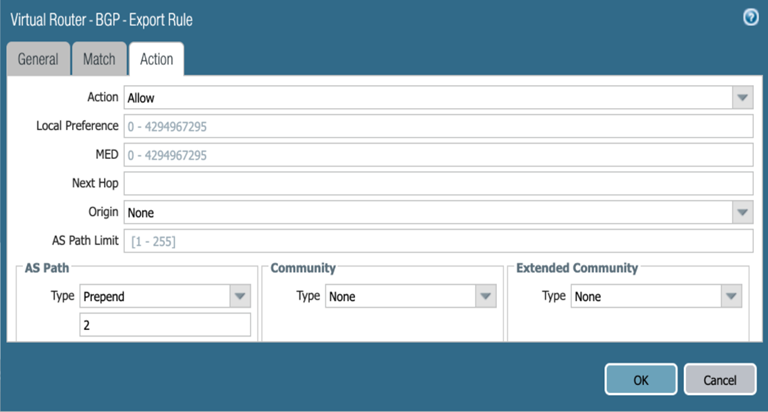Prisma Access
Configure More than Two Service Connections to a Headquarters or Data Center Location
Table of Contents
Expand All
|
Collapse All
Prisma Access Docs
-
- 6.1 Preferred and Innovation
- 6.0 Preferred and Innovation
- 5.2 Preferred and Innovation
- 5.1 Preferred and Innovation
- 5.0 Preferred and Innovation
- 4.2 Preferred
- 4.1 Preferred
- 4.0 Preferred
- 3.2 Preferred and Innovation
- 3.1 Preferred and Innovation
- 3.0 Preferred and Innovation
- 2.2 Preferred
-
-
- 4.0 & Later
- Prisma Access China
-
-
Configure More than Two Service Connections to a Headquarters or Data Center Location
How to configure more than two service connections to
an HQ or data center location.
| Where Can I Use This? | What Do I Need? |
|---|---|
|
|
When you use two tunnels for a high-bandwidth service
connection, there is only one traffic path left available in case of
a tunnel failure, which simplifies the configuration of a failover
path. If you use more than two connections for a high-bandwidth connection,
you need to perform additional configuration to ensure a consistent
behavior for tunnel failovers.
Because you use a summarized
subnet for tunnel failover, you need to explicitly state the service
connection tunnel to use if a failover occurs. Since BGP routing
chooses the shortest number of AS-PATHs for a route, you can prepend
AS-PATHs to routes to have BGP prefer a tunnel in the case of a
failover.
The following example shows routing tables for a
high-bandwidth service connection using three service connections.
If all three tunnels are up, Prisma Access uses the more specific
routes to reach the subnets in the headquarters or data center location. Since
the user is accessing a resource in the 192.168.172.0/24 subnet,
the service connection closest to the mobile user checks its routing
table and selects Tunnel 2 as the path to the data center resource.

If Tunnel
2 goes down, the more specific route to the resource in the 192.168.172.0/24
subnet is not available, so the service connection closest to the
user uses the summarized 192.168.168.0/21 subnet. You have configured
only one AS-PATH prepend for Service Connection 1; therefore, Prisma
Access chooses Tunnel 1 as the failover path because it has fewer
AS-PATH prepends.

To add
prepends to routes if you are using a next-generation firewall as
the CPE, complete the following task.
- Select the virtual router BGP export profiles (NetworkVirtual RoutersBGPExport).Modify the export rule you created when you configured the service connections that has an Action of Allow.
![]() In the AS Path area, add a Prepend, then enter the number of AS-PATH prepends to add (2 in this example).
In the AS Path area, add a Prepend, then enter the number of AS-PATH prepends to add (2 in this example).![]() Repeat Steps 2 and 3 for each export rule that has an Action of Allow, adding AS-PATH prepends to match the failover scenarios you have planned for your deployment.In the examples used in this section, you add an AS-PATH prepend of 1 for the tunnel to the data center location for Service Connection 1 (tunnel.1), an AS-PATH prepend of 2 for the tunnel used for Service Connection 2 (tunnel.2), and an AS-PATH prepend of 3 for the tunnel used for Service Connection 3 (tunnel.3).When complete, this example uses the following tunnels in the even of a failover:
Repeat Steps 2 and 3 for each export rule that has an Action of Allow, adding AS-PATH prepends to match the failover scenarios you have planned for your deployment.In the examples used in this section, you add an AS-PATH prepend of 1 for the tunnel to the data center location for Service Connection 1 (tunnel.1), an AS-PATH prepend of 2 for the tunnel used for Service Connection 2 (tunnel.2), and an AS-PATH prepend of 3 for the tunnel used for Service Connection 3 (tunnel.3).When complete, this example uses the following tunnels in the even of a failover:- If tunnel.2 or tunnel.3 goes down, the traffic for the corresponding subnet fails over to tunnel.1, which has the shortest advertised AS-PATH.
- If tunnel.1 goes down, the traffic for its subnet (192.168.171.0/24) fails over to tunnel.2, which has the shortest advertised AS-PATH.
Add backup PBF or policy-based routing policies to ensure symmetric return traffic in the event of a tunnel failure.While the AS-PATH prepends ensure that the traffic from Prisma Access to the data center uses a specific tunnel in the event of a failover, you must also ensure a symmetric return path for the traffic from the data center to Prisma Access. To ensure symmetric return, use PBF or policy-based routing policies that mirror the failover scenarios you created for traffic from Prisma Access to the data center.In this example, for tunnel.1 traffic that has a source IP of 192.168.171.0/24, you create a backup PBF Policy that forces return traffic to use tunnel.2 in the event of a failover. The first PBF rule becomes disabled if the tunnel monitor IP address is not reachable; when this failover occurs, the CPE (a next-generation firewall in this example) evaluates the next rule in the list.![]() You then add more PBF rules to match the failover scenarios you created for traffic from Prisma Access to the data center.
You then add more PBF rules to match the failover scenarios you created for traffic from Prisma Access to the data center.![]()




